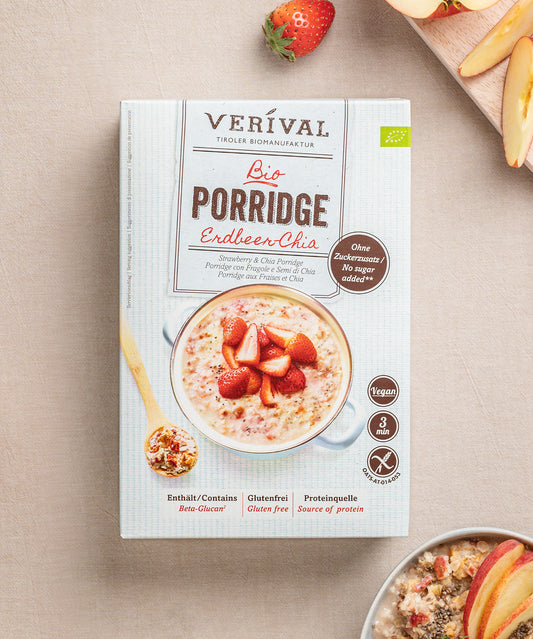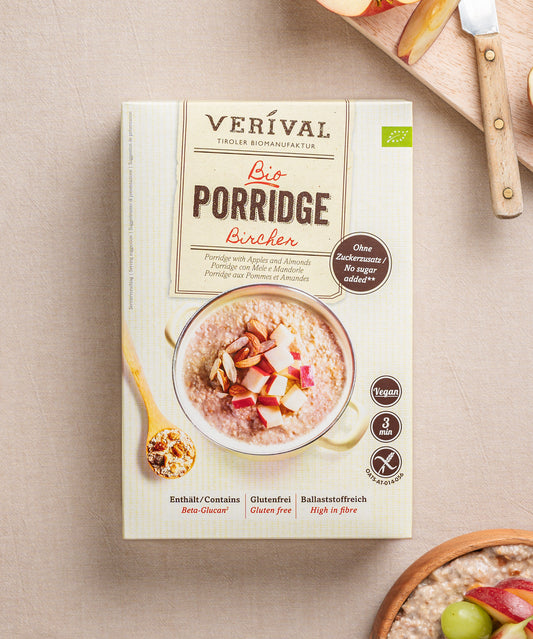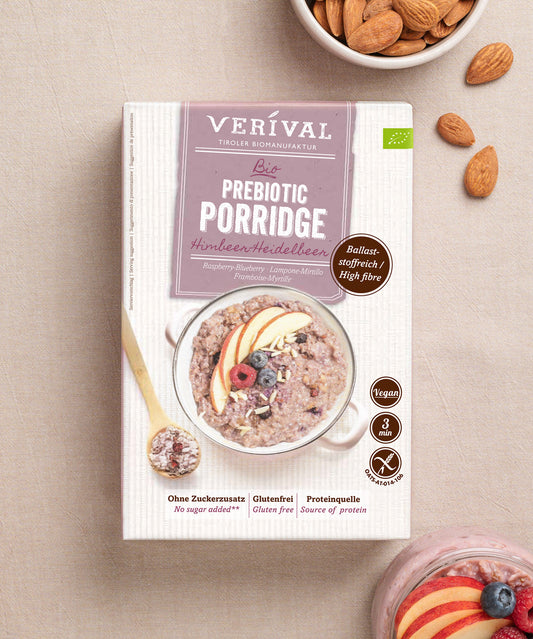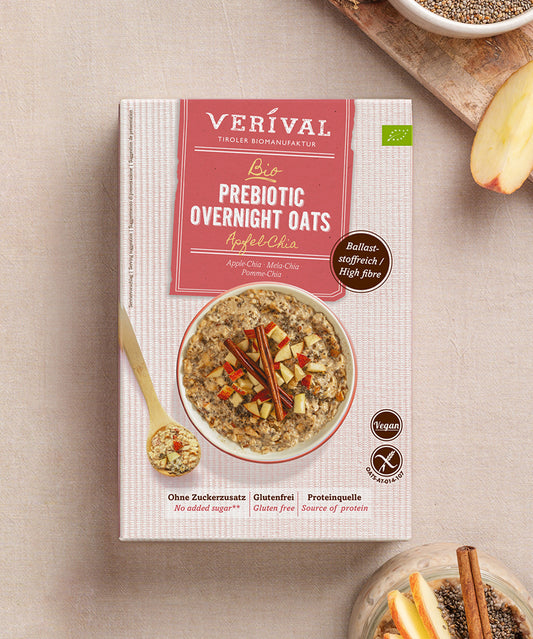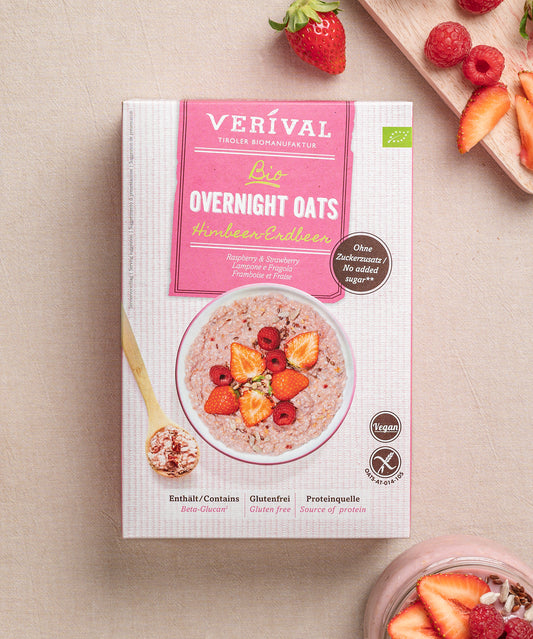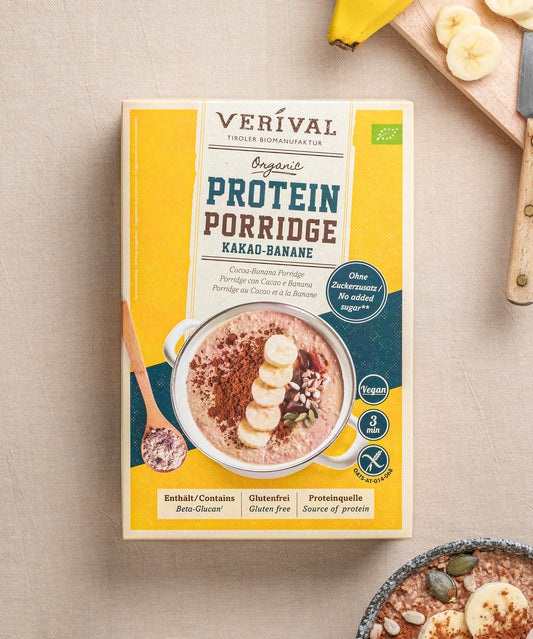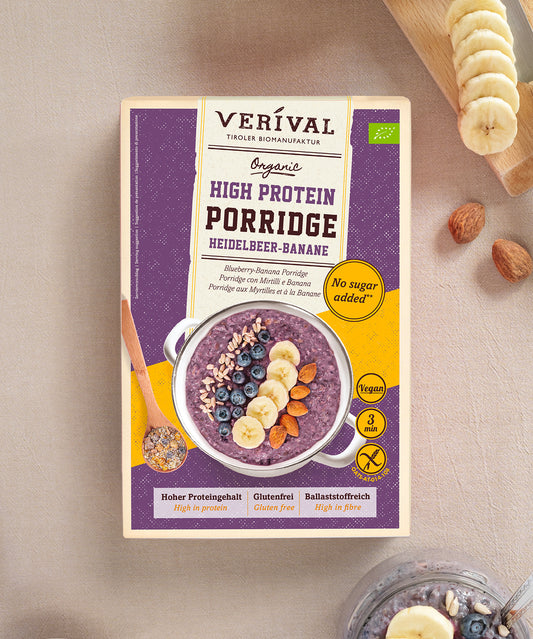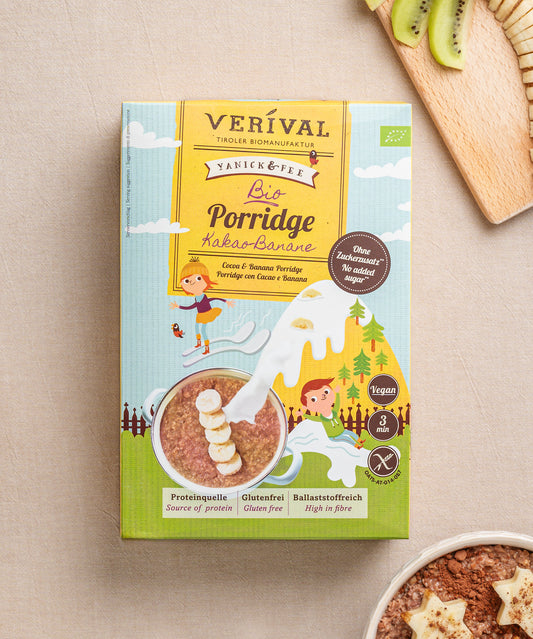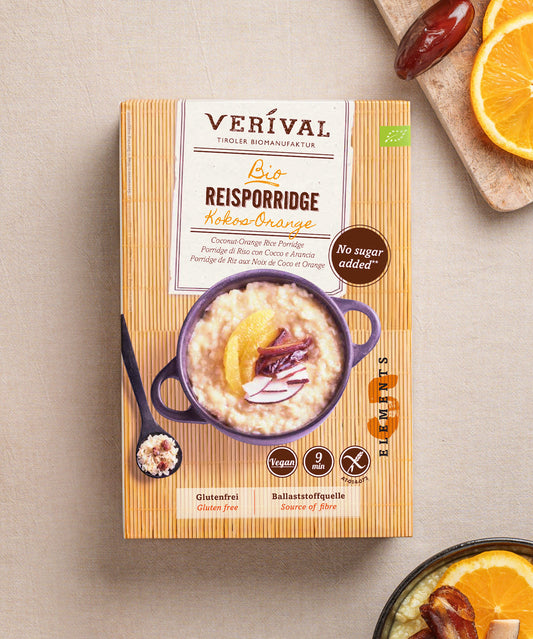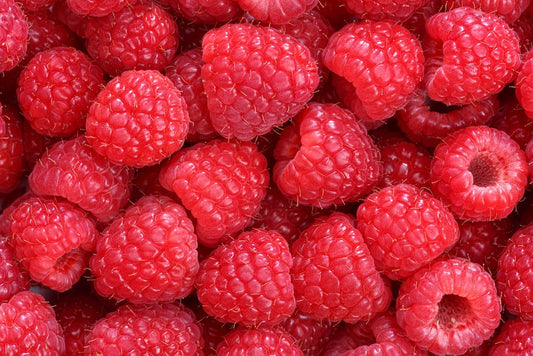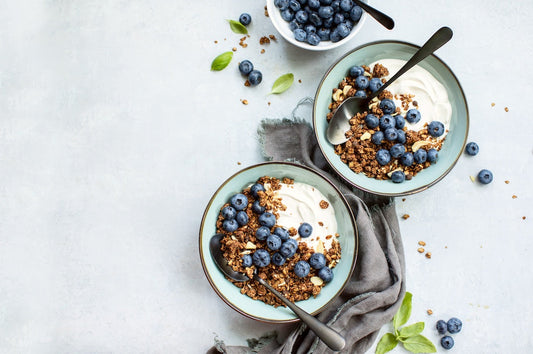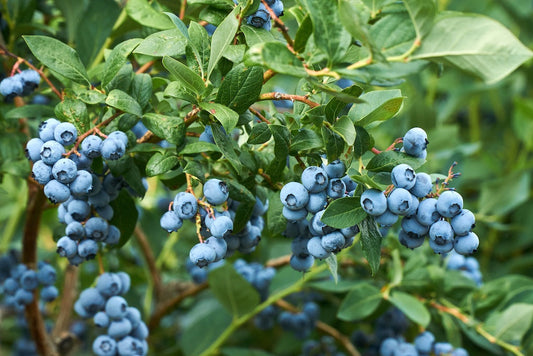Oat bran has long been considered a true superfood and is an essential part of a healthy diet. The reason for this is its high nutrient density and high fiber content. But oat bran has many other health benefits.
In this article, we will take a closer look at how you can incorporate oat bran into your healthy breakfast, the ideal amount of oat bran you should consume, and the health benefits it offers.
Healthy warm porridge for breakfast
What is oat bran?
Oat bran, as the name suggests, is a product made from oats. Unlike oat flakes or oat meal, however, it is not made from the whole grain, but only from the very valuable outer layers (the outer layers of the oat grain) and the seedling of the oat grain.
This ensures a particularly nutty flavor, an increased nutrient density, and potentially greater health benefits. In the course of this article, we will take a closer look at how exactly this popular oat product is made and what its health benefits are.
These are the 6 benefits of the superfood oat bran
Thanks to the special production process and the use of high-quality raw materials, oat bran has a variety of health benefits. These range from improved muscle building to the prevention of cardiovascular diseases. Read more about how healthy oat bran is.
Nutritional value of oat bran
Today we know that oat bran is full of important nutrients for the human organism. The following is an overview of the valuable ingredients:
1 Essential amino acids for fitness
Oat bran is rich in essential amino acids. It performs better than average compared to oat flakes and oat groats. Its nutrient density is also impressive. In particular, the amount of B vitamins and iron is outstanding.
This makes oat bran particularly suitable for athletes. The essential amino acids it contains can promote muscle building and improve performance.
The perfect breakfast for athletes – discover the Verival Sport Range now
2. Micronutrients for the immune system
The high proportion of vitamins and minerals in oat bran is ideal for a healthy breakfast and a successful start to the day. This is due to the diverse functions of micronutrients.
The popular oat product is particularly rich in the trace elements iron, zinc and manganese. A single portion of oat bran thus provides around 25 to 30 percent of the daily requirement.
In terms of vitamins, vitamin B1 and biotin stand out in particular, with a good third of the daily requirement being covered per serving.
In combination with the amino acids, regular consumption can contribute to a fit immune system and thus strengthen your body's defenses.
Oat bran is also rich in folic acid, which is particularly important for metabolic processes, especially for blood formation.
3. Super-fiber beta glucan
A special feature of oat bran is its beta glucan content. 100 grams alone contain around 6.3 grams of beta glucan – almost twice as much as classic oat flakes.
Around 50 grams of oat bran, which is exactly one portion of porridge, already covers the daily requirement of beta glucan. The body rewards this with healthy gut flora and a strong immune system, and it helps to prevent cardiovascular diseases.
4. Blood sugar regulating effect
Due to the large amount of fiber, consuming oat bran has a positive effect on blood sugar levels. Soluble fibers, such as beta glucan, are particularly involved in this.
Even larger amounts of carbohydrates are thus absorbed more slowly by the body. Another advantage is that it can help to prevent type 2 diabetes. In addition, oat bran can be helpful in an insulin-sparing diet, for example for diabetics.
5. Natural satiety
Due to the blood sugar regulating effect of dietary fiber, oats can potentially prevent obesity itself. This is because soluble fibers such as beta-glucan ensure long-lasting satiation.
This helps you avoid food cravings and prevents excessive food intake in a natural and sustainable way.
Like wheat bran, oat bran also increases its volume many times over in the stomach, which also increases stool volume and stimulates intestinal activity.
6. Natural cholesterol-lowering
Oat bran has received a great deal of attention as a natural cholesterol-lowering agent. According to a somewhat old but much-cited study, 1 oat bran lowers bad LDL cholesterol by ten to 20 percent.
The optimal amount is thought to be around 56 grams of oat bran – this reduced LDL cholesterol by a whopping 16 percent in the study participants. This roughly corresponds to one portion of our Verival porridges.
This means that it is even more effective than oat flakes, although these themselves have a positive effect on cholesterol levels.
A low LDL cholesterol level, in combination with a high HDL level, is considered to be beneficial to health and is therefore an important preventive measure with regard to numerous widespread diseases. Read more about the effect of oat bran on cholesterol.
How oat bran is made
The raw material for oat bran is oat grains. In the case of oat bran from Verival, these are high quality organically grown oat grains. These are delivered by selected producers and then cleaned and processed.
The oats are then dried in a process known as kilning, which also preserves them. This gives the oat bran its delicious nutty taste. The next step is known as gritting, during which the husk parts of the grain are separated from the grits. What is ultimately produced is the valuable oat bran.
Waste or quality product?
According to the Austrian food manual, oat bran is “[...] a fraction obtained when grinding dehusked oats [...]”. This may sound more like a by-product of oat-flake production, but it is actually anything but.
It is not just a by-product of oat flour production – in fact, it is increasingly being produced on purpose. The reason for this is its high micronutrient and fiber content . Since these are primarily found in the outer layers of the grain, targeted production makes sense.
If, in addition, high-quality bran is used for production and the process is optimized for production, the result is a high-quality oat product with a high nutrient density.
What is the difference between oat flakes and oat bran?
While oat flakes are made from whole oat grains, oat bran is obtained exclusively from the outer layers of the endosperm and the germ. As a result, it has a more robust consistency and tastes somewhat nuttier.
From a nutritional point of view, both oat products have their advantages. Oat flakes can be used universally and are an excellent source of protein; oat bran, on the other hand, contains more fiber, essential amino acids, vitamins and minerals.
Particularly noteworthy is the high content of beta-glucan in oat bran. This is because beta-glucan is considered a nutrient goldmine. Natural blood pressure reducer, cholesterol reducer or blood sugar regulator are just a few of the names given to beta glucans. The very high selenium content in oat bran has particularly good effects on your immune system, as selenium has an antioxidant effect.
Can you replace rolled oats with oat bran?
That depends on the rolled oats preparation. From a functional point of view, rolled oats can be easily replaced with oat bran. This applies in particular to porridge. This is because the bran, due to the fiber it contains, swells very well, thus ensuring an optimal consistency.
However, not everyone would see oat bran as a suitable substitute in muesli, because, unlike oat flakes, oat bran is very fine and may not be ideal as a topping in yoghurt. However, this is purely a matter of taste.
If you compare the nutritional values of the two oat products, there is no reason not to replace oat flakes with oat bran. Both have a high nutrient density – oat bran even performs better in many aspects.
The following is therefore a brief list of the most important features of oat bran
- Contains almost twice as much beta-glucan as conventional oat flakes (6.2g beta-glucan per 100g)
- Provides you with around 50 percent more fiber than oat flakes
- Contains high amounts of biotin – this vitamin is involved in many metabolic processes and ensures healthy cell growth
What is the best way to eat oat bran?
The question arises as to how best to integrate oat bran into your daily routine. Fortunately, oat bran is very versatile. It is ideal for making porridge or as an energy source i n your muesli or smoothie. It even goes well in pastries such as bread and flour dishes.
It is important to ensure that oat bran is sufficiently hydrated, as otherwise, as is generally the case with high-fiber foods, it can cause constipation.
But first, how much oat bran does your body need per day to reap the health benefits?
How much oat bran can you eat in a day?
The amount of oat bran you should ideally consume each day depends on your individual goal. If you are looking to significantly reduce your blood cholesterol level, 50 to 60 grams is recommended. The fiber in the bran seems to be particularly effective in this range.
With regard to the beta-glucan it contains, about four tablespoons (50-60 grams) of oat bran is enough to fully cover the daily requirement of three grams of beta-glucan.
How to prepare porridge with oat bran
To prepare your porridge with oat bran, just follow these steps. Mix 50 grams of oat bran in a bowl with about 150 to 250 millilitres of boiling water. Alternatively, you can also pour 150 to 250 millilitres of hot milk over it.
Expert tip: The amount of liquid you use depends on the consistency you want. If you're in a hurry, our Verival porridges made with oat bran are the best choice. They make your porridge even faster.
After pouring the liquid over the oat base, stir thoroughly and let the mixture soak for about three minutes. Incidentally, the porridge tastes best when enjoyed warm with delicious toppings.
Here you will find a basic recipe for the perfect oat porridge. You can easily replace the oat flakes with oat bran. If you use vegetable milk, you have a delicious vegan oat porridge variant!
Why not give the recipe a try? Do something good for your gastrointestinal tract and start your day full of health and energy with oat bran – enjoy your meal!
Oat Bran Recipes
Oat bran is the local superfood for a healthy diet.
Here are a few more ideas for incorporating oat bran into your meals:
For example, you can add the grain product to your shakes. There are many delicious shake recipes. Whether you mix milk with bananas or buttermilk with strawberries, 1 spoonful of oat bran is the perfect addition to your power drink!
You can easily bake your own valuable spelt-oat bran bread and consume the healthy fiber that way.
You can also add oat bran to your soup or stew or simply sprinkle a little over your salad.
Frequently asked questions
What can I do with oat bran?
Oat bran is great for your breakfast porridge. You can easily make it by gently simmering the oat bran in liquid and then adding other ingredients of your choice to the creamy porridge. You can also add a spoonful of oat bran to your yogurt with fruit and nuts. Smoothies or shakes with oat bran might be something for you. You can also use the bran in soups or stews. Sprinkled over salad, oat bran tastes good and rounds off a healthy diet.
How much oat bran can you eat in a day?
The recommended daily dose is around 40 g of oat bran. This corresponds to 2 large tablespoons. This ensures you consume a sufficient amount of beta glucan. This fiber, which is found in oat bran, has a positive effect on your blood sugar level and lowers cholesterol. Beta glucan also supports intestinal function and the immune system.
Which is healthier, oats or oat bran?
Both are healthy and both oat products have special advantages. Oats provide a lot of valuable vegetable protein and, due to their complex carbohydrates, keep you full for a long time. Oat bran contains even more fiber, amino acids, vitamins and minerals. You can easily incorporate oat bran into shakes, soups, yoghurt and bread, or prepare a nutritious porridge directly from oat bran, just as you would from oats.
Can you eat oat bran uncooked?
You can, of course, eat oat bran uncooked, i.e. raw. You can sprinkle it on muesli and salads or add it to your smoothie or shake. Oat bran is used cooked or baked in porridge or in soups, stews and bread. The fiber beta glucan found in oat bran has a positive effect on your blood sugar level and lowers cholesterol. Oat bran also supports intestinal function and the immune system.
What happens if I eat oat bran every day?
You are doing your body good! Around 2 heaped tablespoons of oat bran cover your daily requirement of beta glucan. Beta glucan regulates your blood sugar level and lowers your bad cholesterol. You can easily incorporate oat bran into a wide variety of foods.
What does oat bran do in the intestines?
Regular consumption of oat bran (ideally 1-2 heaped tablespoons daily) aids digestion. Your stool will become softer and, if you suffer from constipation, this will be a thing of the past after some time and regular consumption of the bran. Just like wheat bran, oat bran aids your intestinal activity, whereby the latter is even more valuable in terms of nutrients.
How long should oat bran be soaked for?
It is not absolutely necessary to soak oat bran. It can be sprinkled over salad, muesli or soup just as well. However, soaking it reduces the phytic acid content – and this means that the nutrients can be absorbed even better from the oats. Oat flakes should always be soaked if possible – after all, they are coarser than the bran in terms of their structure.
Should you soak oat bran?
Soaking oat products – including the bran – reduces the phytic acid content, making it even easier for the body to absorb the nutrients from the oats. Of course, oat bran can be eaten without soaking, but your body can benefit more from this superfood if the bran has had time to swell.
Which is better, spelt or oat bran?
Both types of grain, spelt and oats, contain many vitamins. Spelt bran, like oat bran, can also be used in a low-carb diet. Wheat bran has no place in a low-carb diet and is also less well tolerated than spelt or oats. Oat bran is ahead in terms of nutritional benefits.
Why should everyone eat oat bran daily?
Oat bran contains even more fiber than the oatmeal itself. Since oat bran contains an extremely high amount of beta glucan, it is beneficial for your bowel movements, lowers your cholesterol and stabilizes your blood sugar. Oat bran consumed daily is a real power food - filling - nutritious - vitalizing.
Is oat bran alkaline or acidic?
Due to the minerals it contains, oats can be used as an alkaline food to regulate the acid-base balance. Oat bran contains a lot of beta glucan and has a positive effect on many bodily functions (blood sugar, blood lipids, digestion, etc.).
Can you lose weight with oat bran?
Oat bran is extremely high in fiber. Oats keep you full for a long time and contain valuable carbohydrates. Even with low carb, oat bran is good to use because the oat product can help you wonderfully with your weight loss. A porridge made from oat bran can provide an ideal and healthy start to your day and you can still lose weight.
What is oat bran healthy for?
Oat bran is a true superfood. It has a low energy density but a high nutrient density. Oat bran provides the body with many important minerals, trace elements and vitamins. Furthermore, oat bran promotes digestion and also has an appetite-suppressing effect, thus helping you to lose weight if you want to. By the way: oat bran contains significantly more unsaturated than saturated fatty acids! Oat bran should therefore not be missing from any diet plan – after all, it has many health benefits. You can enjoy oat bran not only in your smoothie or muesli, but a potato and wild garlic soup with oat bran is also a real power meal!
Is oat bran gluten-free?
Oat bran is usually gluten-free, provided that it has not been contaminated with wheat or other gluten-containing grains during processing. People with gluten intolerance should therefore always take special care to choose products that are specifically labeled as gluten-free.


